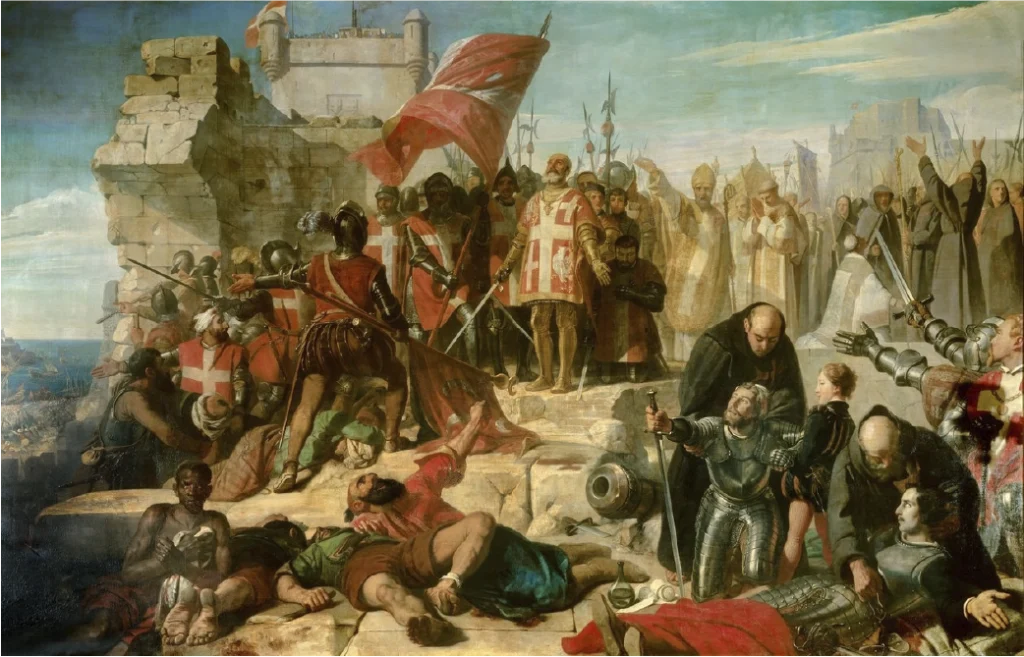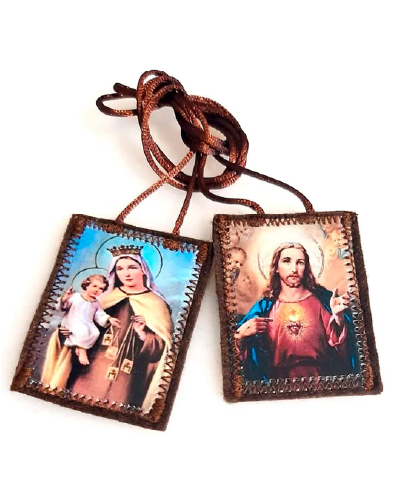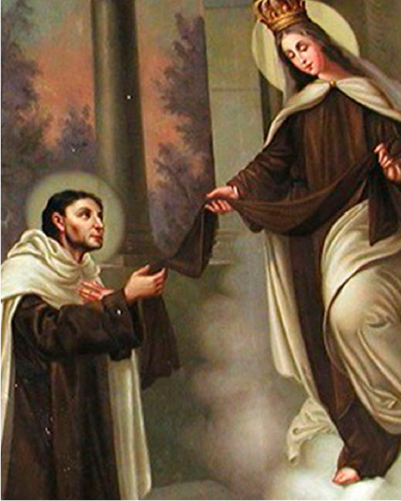The Origin of the Carmelite Order and the Tradition of Mount Carmel
The devotion to the scapular of Our Lady of Mount Carmel is deeply rooted in the history of the Carmelite Order, which traces its origins back to the early centuries of Christianity. Mount Carmel, located in the Holy Land, has held sacred significance since biblical times. It was on this mountain that the prophet Elijah, one of the most revered figures of the Old Testament, waged a spiritual battle against the priests of Baal (1 Kings 18:20-40). Elijah’s victory over pagan worship on Mount Carmel became a symbol of the fight for true faith and later inspired the establishment of a religious order dedicated to living according to principles of solitude, prayer, silence, and surrender to God.
In the 11th century, drawn by the example of the prophet Elijah and the spiritual serenity offered by Mount Carmel, a group of hermits gathered there to lead a life of contemplative prayer and penance. They built a small chapel dedicated to the Virgin Mary, whom they soon referred to as “Our Lady of Mount Carmel.” This laid the foundation for the future Carmelite Order, which would spread across Europe and significantly influence Christian spirituality.
The Crisis Caused by the Crusades and the Arrival of the Carmelites in Europe
With the advance of the Crusades and the increasing Muslim presence in the Holy Land, life for the Carmelite hermits on Mount Carmel became untenable. During the Third and Fourth Crusades, the territory was repeatedly overtaken by Saracen forces, forcing many Christians to flee. Among those who had to abandon their dwellings were the Carmelites, who, in the early 13th century, migrated to Europe, where they faced a new set of challenges.
In Europe, the Carmelites sought to maintain their eremitical way of life but soon discovered that the social and religious context of the continent was vastly different from what they had experienced in the Holy Land. The order faced resistance from both ecclesiastical and secular authorities, primarily due to its contemplative nature and the lack of a clear pastoral mission. Additionally, the Carmelites encountered financial difficulties, as they no longer had the support they once enjoyed, and many members began to abandon the order.

The Apparition of Our Lady to Saint Simon Stock
Amid this crisis, in 1251, the order found its saviour in Saint Simon Stock, who would become the intermediary for one of the most significant moments in Carmelite devotion. Simon Stock, born in England, joined the Carmelite Order in his youth and quickly distinguished himself for his dedication to prayer and spiritual leadership. When the order was on the brink of extinction in Europe, he was elected Superior General.
Recognising the severity of the situation, Saint Simon Stock turned to Our Lady of Mount Carmel in prayer, seeking her divine intervention to save the order. In response to his prayers, he had a vision of the Virgin Mary, who appeared holding the scapular and spoke the words: “Receive, my son, this scapular of your Order. It shall be a sign of salvation, a shield of protection in dangers, and a pledge of peace. Whoever dies wearing it shall not suffer eternal fire.”
This promise of spiritual protection marked the beginning of devotion to the scapular of Our Lady of Mount Carmel. From that moment, the scapular was adopted by the Carmelites as a sign of their consecration to the Virgin Mary and their trust in her intercession.
The Meaning and Importance of the Scapular
In its original form, the scapular was a long piece of fabric that covered the shoulders of Carmelite religious, extending down the front and back. This garment was part of the habit of the order’s members, symbolising the light yoke of Christ, as described in the Gospel (Matthew 11:30). Over time, the scapular was adapted for use by the laity, taking the form we know today: two small pieces of fabric connected by cords, with an image of the Sacred Heart of Jesus on one side and Our Lady of Mount Carmel on the other.
The scapular is an external sign of devotion and personal consecration to Our Lady. It symbolises the desire to live under Mary’s protection and to follow her example of humility, obedience, and service to God. However, the Church teaches that wearing the scapular must be accompanied by a life of prayer, adherence to the commandments, and active participation in the sacraments. It is not an amulet or a magical object but rather a sign of faith and commitment to the Christian life.

The Promise of Our Lady: Salvation for the Devout
The promise of Our Lady of Mount Carmel to Saint Simon Stock—that whoever died wearing the scapular would not suffer eternal damnation—became a central element of this devotion. This promise, known as the “great promise,” was widely spread by the Carmelites and the laity who adopted the scapular. Additionally, Our Lady promised her special protection during life and at the hour of death, ensuring that devotees of the scapular would receive her intercession in their time of greatest need.
It is important to note that this promise should not be interpreted as an automatic guarantee of salvation. The Church teaches that wearing the scapular must be accompanied by a genuine life of faith, marked by the practice of Christian virtues and participation in the sacraments. The scapular is a sign of devotion, not a substitute for the ordinary means of grace.
The Role of Popes and the Church in Promoting Devotion to the Scapular
Over the centuries, devotion to the scapular has been promoted by several popes who recognised its importance as a sign of consecration to Our Lady and commitment to the Christian life. Among the popes who most actively promoted this devotion were Pope John Paul II, a fervent devotee, and Pope Pius XII, who described the scapular as “a sign of consecration to the Immaculate Heart of Mary” and “a means of obtaining her maternal protection.”
Pope Pius XII also granted special indulgences to the faithful who wore the scapular and lived according to the conditions established by the Church, such as observing chastity and reciting daily prayers in honour of Our Lady. These indulgences reinforced the spiritual significance of the scapular and encouraged its widespread adoption among Catholics.


Indulgences and Obligations Associated with the Scapular
As part of the indulgences linked to the scapular, the Church grants devotees who wear the scapular of Our Lady of Mount Carmel the opportunity to obtain a plenary indulgence, provided they meet certain conditions. These include receiving the scapular from an authorised priest, wearing it devoutly as a habit, practising chastity according to one’s state in life, and regularly reciting Marian prayers, such as the Rosary.
One of the best-known indulgences associated with the scapular is the “Sabbatine Indulgence.” According to tradition, this indulgence promises release from purgatory on the first Saturday after death for those who meet certain conditions, including:
- Devoutly wearing the scapular during life.
- Practising chastity according to one’s state in life (whether single or married).
- Reciting prayers in honour of the Virgin Mary, particularly the Office of Our Lady, or, with a priest’s permission, praying the Rosary.
It is important to remember that these indulgences are not automatic, and their value lies in the faithful’s deep desire to consecrate themselves to God and Our Lady, living in accordance with the teachings of the Church. The practice of the scapular is closely tied to a life of grace and participation in the sacraments, especially confession and the Eucharist.